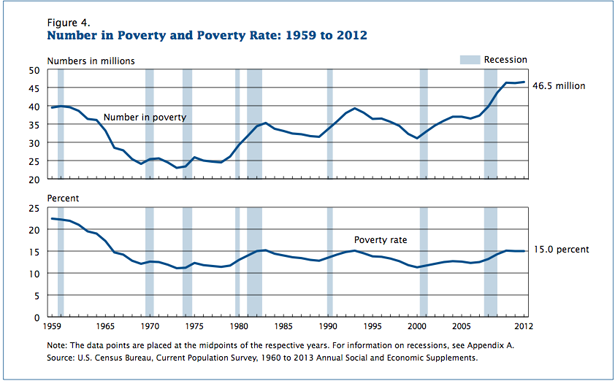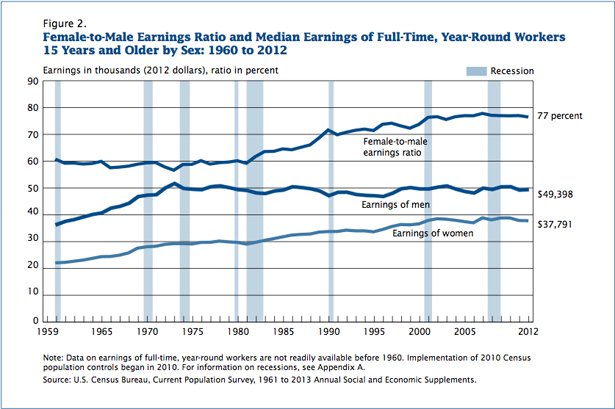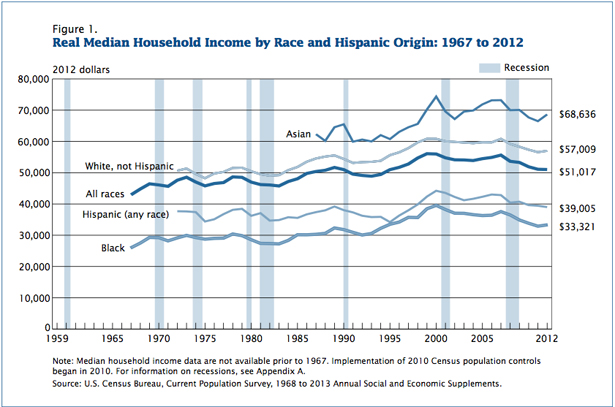
A map at Roadrunner Food Bank in Albuquerque, New Mexico, that depicts food distribution points across the state. (AP Photo/Susan Montoya Bryan)
Exactly five years since the onset of the financial crisis, income data released this morning by the Census Bureau indicates that the spike in poverty triggered by the recession has become the status quo. Middle-class incomes are stagnant, too.
The numbers come as House Republicans move to kick as many as 4 million Americans off food stamps by cutting $40 billion from the program. In their budget proposals, conservatives are also proposing to maintain the deep sequestration reductions that have cut tens of thousands of young children out of Head Start, as well as childcare assistance, Meals On Wheels for seniors, unemployment benefits, and housing assistance.
More than 46 million Americans lived in poverty last year, representing 15 percent of the population. For three years now there have been more Americans in poverty than at any other point since the Census Bureau began collecting data in 1959, and the poverty rate is hovering at its highest level since 1997. While many economists had hoped to see a small decrease in the poverty rate, the only statistically significant change was the additional 300,000 elderly Americans who fell below the poverty line.

“This far out from the great recession it would have been really nice to see gains to income, and reductions in poverty and large increases in health insurance coverage, and we didn’t see any of that,” said Elise Gould, an Economist at the Economic Policy Institute. Overall, she said, the Census figures show that the economic recovery has passed over most Americans. “When I think about economic growth, I think about economic growth for everyday Americans. There we’re talking about median households, median families; we’re also talking about people at the bottom.”
The numbers show that poverty grips women and children particularly fiercely. More than a fifth of all children live in poverty; one in three poor Americans are children. Inequality across race persists, too, with more than a quarter of black and Hispanic Americans living in poverty, compared to just 9.7 percent of whites.
Popular
"swipe left below to view more authors"Swipe →
While the poverty rate rose for both women and men during the recession, the percentage of men in poverty last year was still lower than it has ever been for women. Joan Entmacher, the vice president of Family Economic Security at the National Women’s Law Center, said that decades of unequal wages along with the uneven effects of the recession account for the gender gap. “The jobs that are coming back in this recovery, especially for women, are very low wage jobs. And there aren’t enough of them,” she said.

Entmacher also pointed to the Census’ finding that nearly half of children living in single-parent families headed by women are poor. “If you’re concerned about child poverty and the way it stunts children’s life chances then you have to be concerned about the poverty rate for women,” she said. Reductions in social programs like food stamps and Head Start are particularly devastating to mothers. “Childcare…is absolutely critical if low income women are going to be able to enter and stay in the labor force, but those supports have been cut back,” said Entmacher.
The entrenchment of poverty in American society is alarming on its own, but it is particularly striking in the shadow of a massive rebound in the stock market and in corporate profits. The Census’ measure of inequality in 2012 is on par with the all-time high found the previous year.
The recovery has simply missed most Americans, with the upturn’s benefits accruing largely at the upper echelons of society: the top 1 percent has captured 95 percent of the income gains made since the recession. While income grew by more than 30 percent for the 1 percent between 2009 and 2012, all other Americans together made gains amounting to less than half-of-one percent.

The median income in 2012 was $51,017, still about 8 percent lower than in the year before the financial crisis. But incomes were already falling before the crash; in fact, the peak median income came in 1997. Poverty, too, has been rising since the late 1990s. “It’s really not surprising that we’re seeing flat or stagnant incomes and poverty rates because employment growth has been so modest,” said Gould. “This recovery…[is] really on the tail of thirty years of policies that have been put in place that aren’t really benefiting everyday Americans.”
President Obama acknowledged as much in his speech on Monday. “The trends that have taken hold over the past few decades of a winner-take-all economy…have been made worse by the recession,” he said, and went on to make the case that “what happens up on Capitol Hill” during the current budget showdown is critical to reversing the slide.
Instead of pursuing policies to promote employment and wage increases at the bottom and middle, however, Congress is poised to enact fiscal policies that hit the vulnerable even harder. The proposed Supplemental Nutritional Assistance Program cutbacks are particularly outrageous, but even President Obama’s budget proposal includes a change to the way inflation is calculated that would amount to both a benefit cut and a tax increase for seniors. The tax reforms coming together in the Senate Finance Committee will likely include a lower corporate tax rate, without doing much for poor and middle-class families. It seems unlikely that Congress will lift the sequester anytime soon, which means continued reductions in the social safety net.
The Census figures show that such spending is more essential than ever, as it is these programs rather than the uptick in the economy keeping heads above water. According to the Census, 1.7 million people avoided poverty last year thanks to unemployment insurance. Although neither SNAP benefits nor the Earned Income Tax Credit are counted in the poverty rate, the two programs lifted a combined 9.5 million out of poverty in 2012. And though the full effects of the Affordable Care Act haven’t yet been felt, the level of uninsured Americans continued to fall last year, and the number of uninsured children reached an historic low.
Allison Kilkenny on the Occupy movement’s second anniversary.


